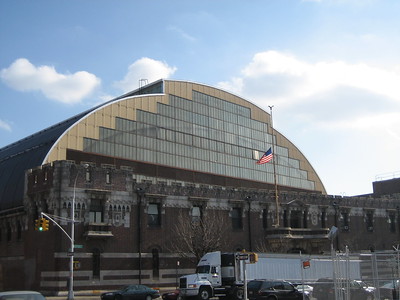A newly opened fitness center in Brooklyn is making a splash, just not the one its operators hope for. The Major R. Owens Health and Wellness Center in the Crown Heights neighborhood opened last month. It occupies a city-owned building – a former Civil War armory.
Crown Heights is not a wealthy place. Its median household income is $35,000-$45,000 annually. The decision to build a fitness center in the Armory came after multiple failed attempts to develop the existing structure into affordable housing. The fitness facility is
So, the residents of Crown Heights were a little put off when the Major Owens Health and Wellness Center revealed its pricing model. The “standard membership” at $30/month provides limited access to the club and a small subset of workout equipment. It excludes access to the Center’s pools, and members must pay for certain classes.
The “signature membership” -which goes for $120 per month, gets open access to the club and classes, but still – no access to the pools. For member who want to swim, they’ll need to buy pool-only access, which will cost an additional $124 per month. For those who don’t want to buy the monthly swim membership, users can pay $25 per lap swim, or $20 per adult and $5 per child during open swim. The 60,000 sq. ft facility includes community and events spaces that are also for rent.
If you’re playing along at home, that’s nearly $1,500 annually for swimming privileges at a public health club in neighborhood where the median income barely clears $3,000 per month. Crown Heights residents charge that the city leased the Armory to developers who didn’t intend to make it available to Crown Heights residents.
When it comes to fitness center operating costs, honesty is the best (managerial) policy
In addition to the standard and premium memberships, the facility makes a limited number of $9 monthly memberships available. They are available only to income eligible households in a specific district. A discount membership provides access only to open lap swims. Discounted swim memberships are also available at $25 per month for income-eligible residents.
I could not help but notice a couple of parallels between this situation and Washtenaw Community College’s Health and Fitness Center. First, WCC built the HFC using campus space and public dollars, but had no intention of inviting its students to the party. The HFC has operated for a decade-and-a-half as a quasi-private health club. Initially, it offered nothing for the students at all. More recently, it has offered extremely limited “academic” programming that enables WCC to access students’ financial aid to help pay for this boondoggle
The second similarity I noted was the cost of operating the facility. The facility memberships and usage fees are much higher than other Brooklyn fitness centers. (They’re not market-competitive.) The developer argues that the increased costs are necessary because its operational costs are high at this facility.
Fitness facilities are expensive to operate and maintain. The Major R. Owens Health and Wellness Center is at least trying to acknowledge this by charging appropriately for services. At 60,000 square feet, the Brooklyn facility is smaller than the Health and Fitness Center at Washtenaw Community College. Which means that over time, the costs to operate the facility will rise even more. The Brooklyn operators don’t have the option of badly oversubscribing the club, as WCC has chosen to do. Nor do they have what amounts to a public trust fund to cover their losses, miscalculations and ill-advised decisions.
Photo Credit: Josh Jackson, via Flickr















